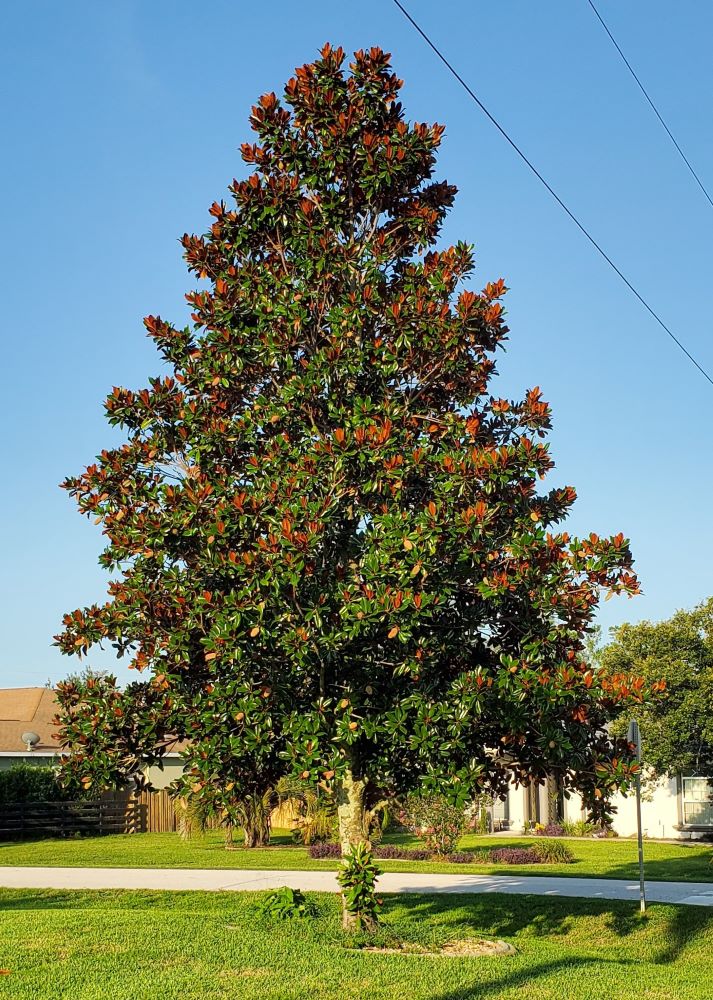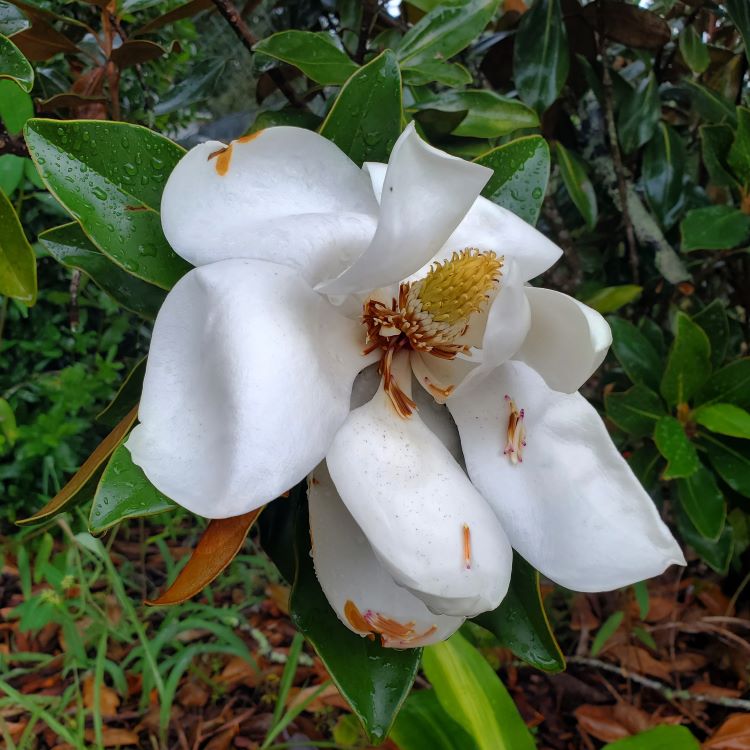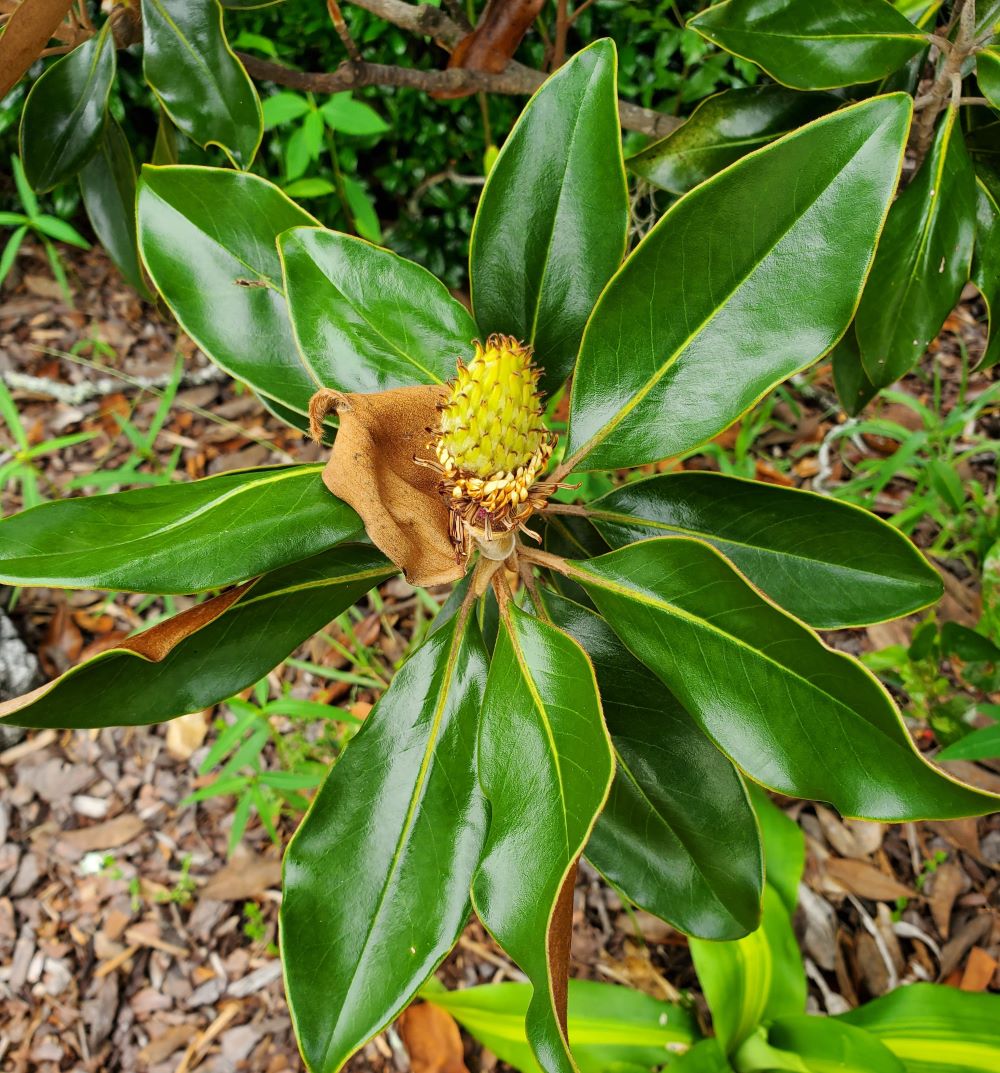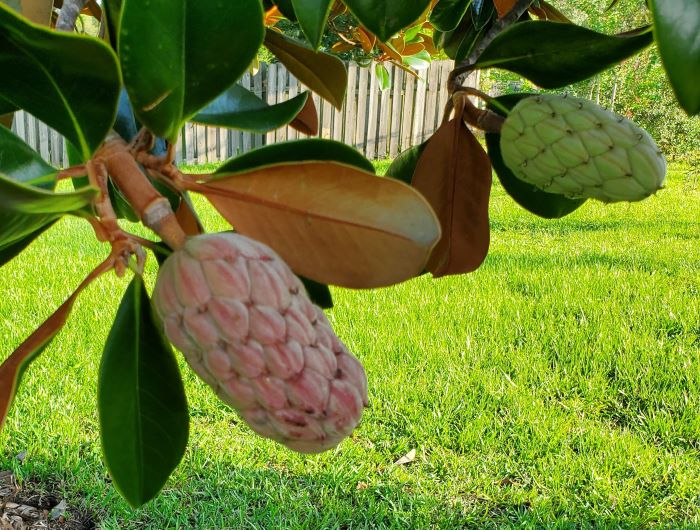
As someone who grew up in the Northeast US, the silhouette of a Southern magnolia hits me as being a bit strange. It is quite clearly a broad-leafed tree, yet can grow in an almost cylindrical shape, branches radiating out from the full length of the trunk like those of a conifer that hasn’t had to grow in competition with other trees. Well, what if I told you that this species is 20 million years old and might be able to tell us a lot about the early evolution of flowering plants?
angiosperm: flowering plant. Even if the plant is not flowering right this moment or has evolved purely vegetative reproduction, it is an angiosperm if it is within the clade of flowering plants. Anatomically speaking, angiosperms are defined by having enclosed ovaries.
basal: coming from a branch off the base of the evolutionary tree. Basal species are the most distantly related to all other species in a clade, and are often used as indications of what ancient species might have looked like.
carpel: a female reproductive organ on a flower. The innermost whorl of organs are carpels. Carpels may fuse into a pistil.
clade: a group containing all species descended from a given common ancestor
petal: floral organ on the next-to-outermost whorl. Petals are often showy in order to attract pollinators.
phylogenetics: the practice of reconstructing evolutionary relationships between species, usually using DNA or protein sequences and physical traits
sepal: floral organ on the outermost whorl. Sepals often look like small leaves although they may be colorful and showy.
stamen: a male reproductive organ on a flower. The next-to-innermost whorl of organs are stamens.
tepal: a type of floral organ, found in some species, that is intermediate between a petal and a sepal.
Ancient flowers
Although bees pollinate a great many species of flowering plants (AKA angiosperms) magnolias have existed longer than bees have an are actually pollinated by beetles who come looking for pollen to eat and then get trapped in the flower overnight (Evich 2021). Because of some unusual characteristics of their flowers, magnolias were for a long time considered to be basal angiosperms (basal meaning they diverged from other angiosperms a long time ago, before most other current lineages existed), but recent evidence indicates that they are much more closely related to other angiosperms than previously thought (Liu, Hilu, and Wang 2014; Yang et al. 2020). Either way, magnolias are part of the Magnoliid clade, which has 10,000 known species, or about 3% of all angiosperm species, and includes familiar plants like avocado, cinnamon, nutmeg, black pepper, bay laurel, and tulip tree. The first fossil evidence of birds eating plants, dated 120 million years ago, is an early bird skeleton with Magnoliid leaves in its stomach (Wu et al. 2023; summarized nicely by Lazaro 2023). The two biggest sister clades to the Magnoliids are the Monocots, which account for 20% of all angiosperm species and include grasses, sedges, lilies, orchids, palms, and others; and the Eudicots, which account for 75% of all angiosperm species and include everything from an oak tree to a dandelion. In Monocots and Eudicots, there are always four whorls of floral organs from outside to inside: sepals, petals, stamens, and carpels. Monocots generally have three of each organ, whereas the Eudicots have varying numbers (often four or five) that are consistent within families. (Note that there are Eudicots, such as the Asteraceae family, with compound flowers. A sunflower has many petals because it is many tiny flowers clustered together.) In magnolias, sepals and petals usually aren’t distinct from each other, and are collectively called by the clever name “tepals”. In our local friend Magnolia grandiflora, there are three whorls of tepals, with three or four tepals each. Moreover, the stamens and carpels are arranged in a spiral, cone-shaped structure reminiscent of a pine cone, without a predetermined number of organs. The stamens and carpels are also more leaf-shaped than those of other flowering plants. (All floral organs originally evolved from leaves.) So it’s not too hard to understand how botanists long considered this plant and its relatives to form a sort of “missing link” between conifers and flowering plants.
If you want a truly basal angiosperm, look at water lilies, such as Nymphaea odorata, which is native here in Florida and much of North America. (Or for a truly truly basal angiosperm, you have to travel to New Caledonia to see Amborella trichopoda.) The flowers of water lilies have an indeterminate number of floral organs, all arranged in a spiral, with continuous change in size and shape as tepals transition to stamens (Kirie et al. 2020).

Phylogenetics
Below is a simplified tree that I drew based on Figure 4 of Yang et al. (2020) (with ferns added based on Pryer et al. (2001)), showing the time scale of evolutionary relationships of vascular plants. I alluded to these relationships in the previous section, but hopefully this diagram will make it easier to understand, and also give you an idea of how old these lineages are.
To reproduce this tree with some Florida native species, I went into NCBI’s Gene database and downloaded protein sequences for a chloroplast gene called atpB. Either DNA or protein sequences can be used to deduce evolutionary relationships, but I chose protein in this case because it changes more slowly than DNA (due to multiple codons corresponding to one amino acid) and I was looking at a very large time scale. The dissimilarities between those protein sequences are visualized in the tree below. The relationships between Eudicots (oak), Monocots (palm), and Magnoliids (magnolia) in the tree should be taken with a grain of salt, because I know from looking at the literature that the result for these three clades changes depending on which gene and species you use. But one cool thing to notice in this tree is that all the flowering plants are relatively close to each other, as compared to the two conifers (pine and cypress) being far apart. Conifers have been around longer and have had more time to diverge, whereas flowering plants are newer, rapidly spreading and diversifying towards the end of the era of the dinosaurs.

You opened this box! Here are the amino acid sequences that I used for constructing the tree. There are 20 amino acids, represented here by 20 letters of the alphabet, that are used to make protein. Their chemical properties determine the shape of the protein as well as any enzymatic properties that it may have. Many amino acids may be changed without impacting the protein’s function, so we can use those changes to deduce evolutionary relationships. For example, at the very beginning and end of the sequence, flowering plants differ considerably from non-flowering plants.
MRINPTTSGPGVSTLEEKNLGRIAQIIGPVLDVAFPPGKMPNIYNALVVKGRDTVGQQINVTCEVQQLLG Magnolia grandiflora YP_007474543.1
MRINPTPSSPVVSTLEEKNLGRIAQIIGPVLDVVFPPGKMPNIYNALVVKGRDTVGQQINVTCEVQQLLG Serenoa repens YP_009247582.1
MRINPTTSDPGVSALEKKNLGRIAQIIGPVLDVTFPPRKMPNIYNALVVKGRDTAGQQINVTCEVQQLLG Quercus virginiana YP_009942178.1
MRINPTTSGLGVSTLVEKNQGRIAQIIGPVLDVAFPPGKMPNIYNSLVVKGRDTAGQEINVTCEVQQLLG Nymphaea odorata YP_010167551.1
MRKNPLVLG--VSARVEKNVGRIAQIIGPVLDVSFPPGNMPNIYNSLTVKGQGTAGQEIQVTCEVQQLLG Pinus elliottii YP_009653955.1
MRTNPFILG--VSALVEKKAGRIDQIIGPVLDVSFPPGNMPRIYNSLIVKDNDTTGQSISVTCEVQQLLG Taxodium distichum YP_009379876.1
MKTSSLALG--ISTSVEKNVGYITQIIGPVLDVALSPGKMPNIYNSPIVKGQNPAGQEINVTREVQQLLG Osmundastrum cinnamomeum YP_009032831.1
NNRVRAVAMSATEGLMRGMEVIDTGAPLSVPVGGATLGRIFNVLGEPVDNLGPVDTRTTSPIHRSAPAFI Magnolia grandiflora YP_007474543.1
NNRVRAVAMSATDGLMRGMEVIDTGAPLSVPVGGATLGRIFNVLGEPVDNLGPVDTRTTSPIHRSAPAFI Serenoa repens YP_009247582.1
NNRVRAVAMSATDGLMRGMEVIDTGAPLSVPVGGATLGRIFNVLGEPVDNLGPVDTRTTSPIHRSAPAFI Quercus virginiana YP_009942178.1
NNRVRAVAMSATDGLTRGMEVIDTGAPLSVPVGGATLGRIFNVLGEPVDNLGPVDTRTTSPIHRAAPAFT Nymphaea odorata YP_010167551.1
NHKVRAVAMSATDGLTRGMRVIDTGAPLSVPVGGATLGRIFNVLGEPVDNLGPVDAGITSAIHRPAPAFT Pinus elliottii YP_009653955.1
NNKVRAVAMSATDGLMRGMKVIDTGGPLSVPVGETTLGRIFNVLGEPVDDLGPVDALTRSPIHRSAPAFT Taxodium distichum YP_009379876.1
NNEVRAVAMSATDGLMRGMDVIDTGAPLSVPVGEITLGRIFNVPGEPVDNLGPVDTGITSPIHRSAPAFT Osmundastrum cinnamomeum YP_009032831.1
QLDTKLSIFETGIKVVDLLAPYRRGGKIGLFGGAGVGKTVLIMELINNIAKAHGGVSVFGGVGERTREGN Magnolia grandiflora YP_007474543.1
QLDTKLSIFETGIKVVDLLAPYRRGGKIGLFGGAGVGKTVLIMELINNIAKAHGGVSVFGGVGERTREGN Serenoa repens YP_009247582.1
QLDTKLSIFETGIKVVDLLAPYRRGGKIGLFGGAGVGKTVLIMELINNIAKAHGGVSVFGGVGERTREGN Quercus virginiana YP_009942178.1
QLDTKLSIFETGIKVVDLLAPYRRGGKIGLFGGAGVGKTVLIMELINNIAKAHGGVSVFGGVGERTREGN Nymphaea odorata YP_010167551.1
ELDTKLSIFETGIKVVDLLAPYRRGGKIGLFGGAGVGKTVLIMELINNIAKAHGGVSVFGGVGERTREGN Pinus elliottii YP_009653955.1
QLDTRFSIFETGIKVVDLLAPYRRGGKIGLFGGAGVGKTVLIMELINNIAKAHGGVSVFGGVGERTREGN Taxodium distichum YP_009379876.1
QLDTKLSIFETGIKVVDLSAPYRRGGKIGLFGGAGVGKTVPIMESINNIAKAHGGVSVSGGVGERTREGN Osmundastrum cinnamomeum YP_009032831.1
DLYMEMKESGVINEQNIAESKVALVYGQMNEPPGARMRVGLTALTMAEYFRDVNEQDVLLFIDNIFRFVQ Magnolia grandiflora YP_007474543.1
DLYMEMKESGVINEKNIAESKVALVYGQMNEPPGARMRVGLTALTMAEYFRDVNEQDVLLFIDNIFRFVQ Serenoa repens YP_009247582.1
DLYMEMKESGVINEQNIAESKVALVYGQMNEPPGARMRVGLTALTMAEYFRDVNEQDVLLFIDNIFRFVQ Quercus virginiana YP_009942178.1
DLYMEMKESGVINEENIAESKVALVYGQMNEPPGARMRVGLTALTMAEYFRDVNEQDVLLFIDNIFRFVQ Nymphaea odorata YP_010167551.1
DLYMEMKESGVIDEQKISESKVALVYGQMNEPPGARMRVGLTALTMAEYFRDVNEQDVLLFIDNIFRFVQ Pinus elliottii YP_009653955.1
DLYKEMKESGVINEQNISKSKVALVYGQMNEPPGARMRVGLTALTMAEYFRDVNKQDVLLFIDNIFRFVQ Taxodium distichum YP_009379876.1
DLYMEMKESKVINEQNISESKVALVYGQMNEPPGARMRVGLTALTMAEYFRDVNKQDVLLFIDNILRFVQ Osmundastrum cinnamomeum YP_009032831.1
AGSEVSALLGRMPSAVGYQPTLSTEMGSLQERITSTKEGSITSIQAVYVPADDLTDPAPATTFAHLDATT Magnolia grandiflora YP_007474543.1
AGSEVSALLGRMPSAVGYQPTLSTEMGSLQERITSTKEGSITSIQAVYVPADDLTDPAPATTFAHLDATT Serenoa repens YP_009247582.1
AGSEVSALLGRMPSAVGYQPTLSTEMGSLQERITSTKEGSITSIQAVYVPADDLTDPAPATTFAHLDATT Quercus virginiana YP_009942178.1
AGSEVSALLGRMPSAVGYQPTLSTEMGSLQERITSTKEGSITSIQAVYVPADDLTDPAPATTFAHLDATT Nymphaea odorata YP_010167551.1
AGSEVSALLGRMPSAVGYQPTLSTEMGSLQERITSTKKGSITSIQAVYVPADDLTDPAPATTFAHSDATT Pinus elliottii YP_009653955.1
AGSEVSALLGRMPSAVGYQPTLSTEMGSLQERITSTKEGSITSIQAVYVPADDLTDPAPATTFAHLDATT Taxodium distichum YP_009379876.1
AGSEVSALLGRMPSAVGYQPTLSTEMGSLQERITSTKEGSITSIQAVYVPADDSTDPAPATTFAHPDATT Osmundastrum cinnamomeum YP_009032831.1
VLSRGLAAKGIYPAVDPLDSTSTMLQPRIVGEEHYETAQRVKQTSQRYKELQDIIAILGLDELSEEDRLT Magnolia grandiflora YP_007474543.1
VLSRVLAAKGIYPAVDPLDSTSTMLQPRIVGEEHYETAQRVKQTSQRYKELQDIIAILGLDELSEEDRLT Serenoa repens YP_009247582.1
VLSRGLAAKGIYPAVDPLDSTSTMLQPRIVGEEHYETAQRVKQTLQRYKELQDIIAILGLDELSEEDRLT Quercus virginiana YP_009942178.1
VLSRGLAAKGIYPAVDPLDSTSTMLQPRIVGEEHYETAQRVKQTLQRYKELQDIIAILGLDELSEEDRLT Nymphaea odorata YP_010167551.1
VLSRGLAAKGIYPAVDPLDSTSTMLQPWIVGEEHYETAQGVKQTLQRYKELQDIIAIPGLDELSEEDRLI Pinus elliottii YP_009653955.1
VLSRGLAAKGIYPAVDPLDSTSTMLQPSIVGEEHYETAQGVKQTLQRYKELQDIIAILGLDELSEDDRLI Taxodium distichum YP_009379876.1
VLPRGLAAKGIYPAVDPLDPTPTMLQPWIVGEEHYETAQGVKQTLQRYKEPQDIIAILGLDELSEEDRLT Osmundastrum cinnamomeum YP_009032831.1
VARARKIERFLSQPFFVAEVFTGSPGKYVGLAETIRGFQLILSGEFDGLPEQAFYLVGNIDEATAKAMNL Magnolia grandiflora YP_007474543.1
VARARKIERFLSQPFFVAEVFTGSPGKYVGLGETIRGFQLILSGELDGLPEQAFYLVGNIDEATAKAMNL Serenoa repens YP_009247582.1
VARARKIERFLSQPFFVAEVFTGSPGKYVGLSETIRGFKLILSGELDGLPEQAFYLVGNIDEATAKATNL Quercus virginiana YP_009942178.1
VARARKIERFLSQPFFVAEVFTGSPGKYVGLAETIRGFQLILSGELDSFPEQAFYLVGNIDEATAKAMNL Nymphaea odorata YP_010167551.1
VARARKIERFLSQPFFVAEVFTGSPGKYVGLMETIRGFQMILSGELDGLIEQSFYLVGNIDEATAKAINS Pinus elliottii YP_009653955.1
VARARKIERFLSQPFFVAEVFTGSPGKYVSLIDTIKGFQMILSGELDDLPEQSFYLVGNIDEATAKAMNL Taxodium distichum YP_009379876.1
VARARKIERFLSQPFFVAEVFTGSPGKYVSPIETIKGFQMILSGELDSLPEQASYLVGNIDEATAKAATL Osmundastrum cinnamomeum YP_009032831.1
EVESKLKK Magnolia grandiflora YP_007474543.1
EVESKLKK Serenoa repens YP_009247582.1
EMESKLKQ Quercus virginiana YP_009942178.1
EVESKLKK Nymphaea odorata YP_010167551.1
NMES---- Pinus elliottii YP_009653955.1
KEI----- Taxodium distichum YP_009379876.1
QVESR--- Osmundastrum cinnamomeum YP_009032831.1Why is it so difficult to sort out the relationship between Magnoliids, Monocots, and Eudicots, especially in this day and age when we have a complete genome sequence of many plants? One reason is that they diverged from each other in a “short” period of time over about 25 million years, possibly due to a rapid radiation as the world’s climate got wetter (Yang et al. 2020). The other reason mentioned by Yang et al. is incomplete lineage sorting, meaning that (1) genes could have started diverging within species before the species themselves diverged, or (2) after species divergence, genes could have moved from one species to another by hybridization or viruses. Anyway, the take home message is that insect pollination was a very advantageous trait, allowing flowering plants to spread very quickly around the world.
Spirituality
The spiral is an important symbol in druidry, and goes back many thousands of years, for example to the New Grange monument. It moves in a circle following the cycle of the day or year, but also moves outward or inward. To me, the spiral represents the pull to the otherworld, to a different state of consciousness, to a different perspective. If we look at conifers and water lilies we see that a spiral is the ancestral way for a plant to arrange its reproductive organs. The magnolia is one of the most “modern” plants to retain (or possibly revert back to) this spiral shape, while its relatives who were quickly overtaking the world had switched to a system of four tidy concentric circles, each with a predetermined number of organs. Just like a sedge has a stem with a triangular cross-section reflecting floral organs in multiples of three, and many blackberries have stems with pentagonal cross sections reflecting five sepals and five petals, perhaps if you connect with the spirit of a magnolia you will feel the latent spiral within the tree itself.
If you are familiar with the tale of Ceridwen and Taliesin, the image of a beetle trapped overnight within white tepals, fertilizing the flower and then being released in the morning rich with pollen, might be evocative of that story for you.
The big, thick leaves of a magnolia, with their brown hairy undersides, give the feeling of a plant that is tough, earthy, and resilient. Yet the enormous, showy flowers are pure joy. Druidry teaches us that to find wisdom, we must embrace both the serious and the playful sides of our nature. If this tree species has stuck around for 20 million years, clearly it is doing something right!








